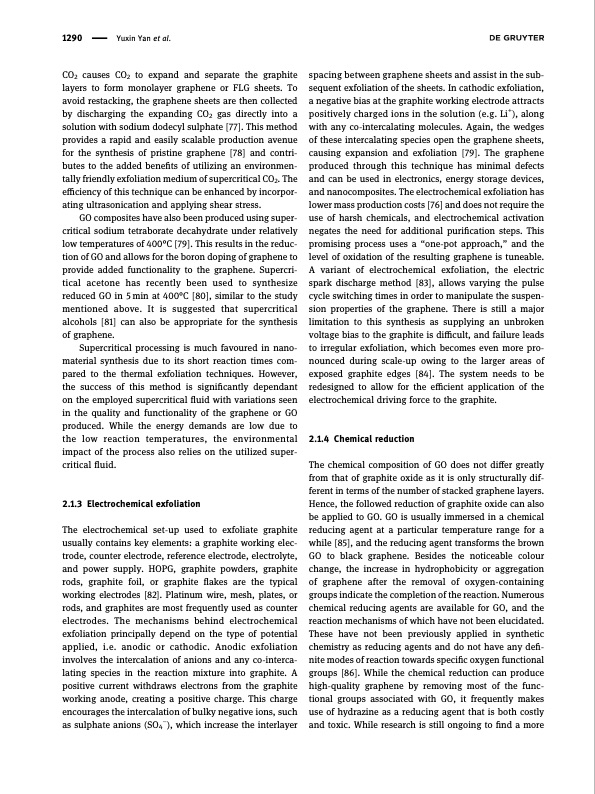
PDF Publication Title:
Text from PDF Page: 007
1290 Yuxin Yan et al. CO2 causes CO2 to expand and separate the graphite layers to form monolayer graphene or FLG sheets. To avoid restacking, the graphene sheets are then collected by discharging the expanding CO2 gas directly into a solution with sodium dodecyl sulphate [77]. This method provides a rapid and easily scalable production avenue for the synthesis of pristine graphene [78] and contri- butes to the added benefits of utilizing an environmen- tally friendly exfoliation medium of supercritical CO2. The efficiency of this technique can be enhanced by incorpor- ating ultrasonication and applying shear stress. GO composites have also been produced using super- critical sodium tetraborate decahydrate under relatively low temperatures of 400°C [79]. This results in the reduc- tion of GO and allows for the boron doping of graphene to provide added functionality to the graphene. Supercri- tical acetone has recently been used to synthesize reduced GO in 5 min at 400°C [80], similar to the study mentioned above. It is suggested that supercritical alcohols [81] can also be appropriate for the synthesis of graphene. Supercritical processing is much favoured in nano- material synthesis due to its short reaction times com- pared to the thermal exfoliation techniques. However, the success of this method is significantly dependant on the employed supercritical fluid with variations seen in the quality and functionality of the graphene or GO produced. While the energy demands are low due to the low reaction temperatures, the environmental impact of the process also relies on the utilized super- critical fluid. 2.1.3 Electrochemical exfoliation The electrochemical set-up used to exfoliate graphite usually contains key elements: a graphite working elec- trode, counter electrode, reference electrode, electrolyte, and power supply. HOPG, graphite powders, graphite rods, graphite foil, or graphite flakes are the typical working electrodes [82]. Platinum wire, mesh, plates, or rods, and graphites are most frequently used as counter electrodes. The mechanisms behind electrochemical exfoliation principally depend on the type of potential applied, i.e. anodic or cathodic. Anodic exfoliation involves the intercalation of anions and any co-interca- lating species in the reaction mixture into graphite. A positive current withdraws electrons from the graphite working anode, creating a positive charge. This charge encourages the intercalation of bulky negative ions, such as sulphate anions (SO4−), which increase the interlayer spacing between graphene sheets and assist in the sub- sequent exfoliation of the sheets. In cathodic exfoliation, a negative bias at the graphite working electrode attracts positively charged ions in the solution (e.g. Li+), along with any co-intercalating molecules. Again, the wedges of these intercalating species open the graphene sheets, causing expansion and exfoliation [79]. The graphene produced through this technique has minimal defects and can be used in electronics, energy storage devices, and nanocomposites. The electrochemical exfoliation has lower mass production costs [76] and does not require the use of harsh chemicals, and electrochemical activation negates the need for additional purification steps. This promising process uses a “one-pot approach,” and the level of oxidation of the resulting graphene is tuneable. A variant of electrochemical exfoliation, the electric spark discharge method [83], allows varying the pulse cycle switching times in order to manipulate the suspen- sion properties of the graphene. There is still a major limitation to this synthesis as supplying an unbroken voltage bias to the graphite is difficult, and failure leads to irregular exfoliation, which becomes even more pro- nounced during scale-up owing to the larger areas of exposed graphite edges [84]. The system needs to be redesigned to allow for the efficient application of the electrochemical driving force to the graphite. 2.1.4 Chemical reduction The chemical composition of GO does not differ greatly from that of graphite oxide as it is only structurally dif- ferent in terms of the number of stacked graphene layers. Hence, the followed reduction of graphite oxide can also be applied to GO. GO is usually immersed in a chemical reducing agent at a particular temperature range for a while [85], and the reducing agent transforms the brown GO to black graphene. Besides the noticeable colour change, the increase in hydrophobicity or aggregation of graphene after the removal of oxygen-containing groups indicate the completion of the reaction. Numerous chemical reducing agents are available for GO, and the reaction mechanisms of which have not been elucidated. These have not been previously applied in synthetic chemistry as reducing agents and do not have any defi- nite modes of reaction towards specific oxygen functional groups [86]. While the chemical reduction can produce high-quality graphene by removing most of the func- tional groups associated with GO, it frequently makes use of hydrazine as a reducing agent that is both costly and toxic. While research is still ongoing to find a morePDF Image | Synthesis of graphene Potential carbon precursors

PDF Search Title:
Synthesis of graphene Potential carbon precursorsOriginal File Name Searched:
10-1515-ntrev-2020-0100.pdfDIY PDF Search: Google It | Yahoo | Bing
Salgenx Redox Flow Battery Technology: Power up your energy storage game with Salgenx Salt Water Battery. With its advanced technology, the flow battery provides reliable, scalable, and sustainable energy storage for utility-scale projects. Upgrade to a Salgenx flow battery today and take control of your energy future.
| CONTACT TEL: 608-238-6001 Email: greg@infinityturbine.com | RSS | AMP |